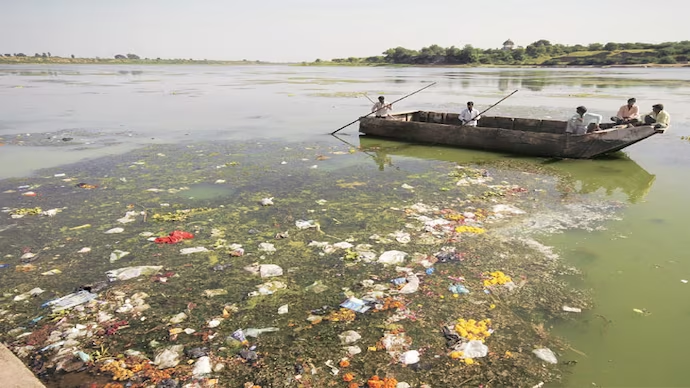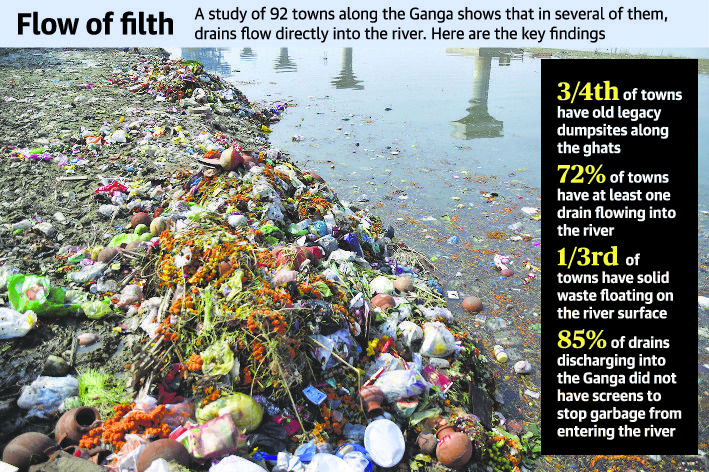Description

Copyright infringement not intended
Picture Courtesy: https://www.indiatoday.in/mail-today/story/polluted-rivers-indian-environment-survey-247101-2015-02-13
Context: Rivers play a crucial role in India's socio-economic and cultural fabric, providing freshwater for agriculture, drinking, and industrial use. However, the rapid pace of urbanization, industrialization, and agricultural intensification has led to severe water pollution, threatening the health of river ecosystems and human populations.
Details
- The Central Pollution Control Board (CPCB) monitors water quality at numerous locations across India, including rivers, lakes, ponds, tanks, creeks, marine areas, wells, and other water bodies. This monitoring involves assessing indicators like Biochemical Oxygen Demand (BOD) to identify polluted river stretches and areas exceeding pollution thresholds.
- The CPCB's analysis reveals that a significant percentage of monitored locations do not comply with BOD criteria, indicating organic pollution. Based on BOD levels, CPCB identified 311 polluted river stretches across 279 rivers in 30 states and union territories in 2022.

Causes of Water Pollution in Indian Rivers
Urbanization and Industrialization
- Uncontrolled Discharge of Industrial Effluents: Many industries discharge untreated or inadequately treated effluents directly into rivers, containing heavy metals, chemicals, and organic pollutants. Examples include textile dyeing units, tanneries, chemical factories, and thermal power plants.
- Inadequate Sewage Treatment and Disposal: Urban centres often lack sufficient sewage treatment infrastructure, leading to raw sewage being dumped into rivers. Untreated sewage introduces pathogens, nutrients, and organic matter into water bodies
Agricultural Activities
- Pesticide and Fertilizer Runoff: Excessive use of chemical fertilizers and pesticides in agriculture results in runoff during rains, contaminating rivers with nitrogen, phosphorus, and pesticides.
- Soil Erosion and Sedimentation: Deforestation and improper land use practices contribute to soil erosion, increasing sediment load in rivers, which affects water quality and aquatic habitats.
Religious and Cultural Practices
- Immersion of Idols and Offerings: During festivals, idols made of non-biodegradable materials are immersed in rivers, contributing to water pollution. Organic offerings like flowers and food items also degrade water quality.
- Disposal of Human and Animal Remains: Ritualistic practices of disposing of human and animal remains in rivers add organic matter and pathogens, impacting water quality.
Deforestation and Land Use Changes
- Increased Sediment Load: Deforestation along riverbanks and in catchment areas leads to increased soil erosion, sedimentation, and siltation in rivers. Sediment reduces water clarity and disrupts aquatic habitats.

Impact of Water Pollution
Public Health Concerns
- Waterborne Diseases: Contaminated river water is a source of waterborne diseases such as cholera, typhoid, dysentery, and hepatitis. Poor sanitation and hygiene exacerbate health risks.
- Chronic Health Issues: Long-term exposure to polluted water can cause chronic health problems, including respiratory ailments and skin diseases.
Ecological Consequences
- Decline in Biodiversity: Pollution adversely affects aquatic flora and fauna, leading to the decline of fish populations and loss of biodiversity.
- Ecosystem Disruption: Altered water quality and habitat degradation disrupt the balance of river ecosystems, affecting species interactions and ecological functions.
Economic Ramifications
- Costs of Water Treatment and Healthcare: Treating polluted water for drinking and industrial use incurs significant costs for governments and communities. Healthcare expenses due to waterborne illnesses strain public resources.
- Impact on Fisheries and Agriculture: Polluted rivers adversely affect fisheries and agriculture, reducing productivity and livelihoods dependent on river resources.
Case Studies: Polluted Rivers in India
- River Ganga: The Ganga is revered as a sacred river but faces severe pollution challenges. Ganga receives untreated sewage, industrial effluents, and religious offerings, leading to high pollution levels.
- River Yamuna: Yamuna is highly polluted due to industrial discharge, sewage influx, and lack of flow during dry seasons. Various government programs like Namami Gange aim to clean and rejuvenate the Yamuna and other rivers.
Government Initiatives and Policy Measures
- National Mission for Clean Ganga (Namami Gange): Focuses on reducing pollution, improving sewage treatment, and promoting sustainable river management practices. Efforts have been made to clean the Ganga, but challenges remain due to complex socio-economic factors.
- Role of State Pollution Control Boards: State-level bodies monitor water quality, enforce regulations, and implement pollution control measures.
- Community Participation and Awareness Campaigns: Engaging local communities and stakeholders in river conservation efforts through awareness and capacity-building programs.
Way Forward
Strengthening Pollution Control Measures
- Strict enforcement of pollution control laws and standards for industries and municipalities.
- Investment in sewage treatment plants and decentralized wastewater management systems.
Promoting Sustainable Practices
- Promoting organic farming practices to reduce chemical runoff into rivers.
- Implementing waste segregation at source and promoting recycling of materials to reduce river pollution.
Public Awareness and Stakeholder Engagement
- Conducting awareness campaigns to promote water conservation and responsible river use.
- Collaborating with non-profits and community organizations for river cleanup drives and conservation initiatives.
Conclusion
- Addressing water pollution in Indian rivers requires a holistic approach involving stringent regulations, sustainable practices, community engagement, and government initiatives. By safeguarding our rivers, we protect vital ecosystems and ensure access to clean water for present and future generations.
Must Read Articles:
GROUNDWATER CONTAMINATION IN INDIA
Source:
Down to Earth
PIB
|
PRACTICE QUESTION
Q. Unequal access to sanitation and wastewater treatment facilities disproportionately affects marginalized communities living near polluted rivers. How can India design water pollution mitigation strategies that address social equity concerns and ensure access to clean water for all, especially those most vulnerable?
|












